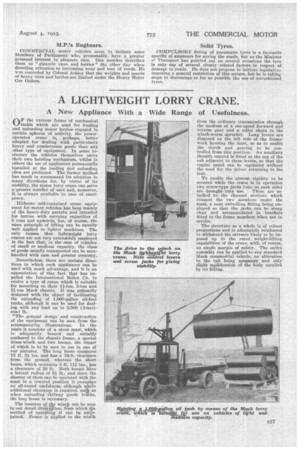A LIGHTWEIGHT LORRY CRANE.
Page 11

If you've noticed an error in this article please click here to report it so we can fix it.
A New Appliance With a Wide Range of Usefulness,
r1P the various forms of mechanical ‘..../tackle which are used for loading and unloading motor lorries engaged in certain spheres of activity, the poweroperated crane is, perhaps, better adapted for dealing with particularly heavy and cumbersome goods than any other type of equipment. In some instances the vehicles themselves carry their own hoisting mechanism, whilst in others the use of appliances permanently installed at the loading and unloading rites are preferred. The former method has much to recommend its adoption in many directions for, by virtue of its mobility, the motor lorry crane can serve a greater number of uses and, moreover, it is always available in case of emergency.
Hitherto self-contained crane equipment for motor vehicles has been mainly of the heavy-duty pattein and intended for lorries with carrying capacities of 5 tons and upwards, but, of course, the same principle of lifting can be equally well applied to lighter machines. The only reason that lightweight lorry cranes are not very extensively employed is the fact that, in the case of vehicles of small or medium capacity, the class of goods usually transported can be manhandled with ease and greater economy.
Nevertheless, there are certain directions in which such appliances can be used with much advantage, and it is an appreciation of this fact that has impelled the International Motor Co. to evolve a type of crane which is suitable for mounting on their 11-ton, 2-ton and 2i-ton Mack chassis. It was primarily designed with the object of facilitating the unloading of 1,000-gallon oil-fuel tanks, although it can be used for dealing with any load up to 2,500 (American) lb.
°The general design and construction of the equipment can be seen from the accompanying illustrations. In the main it consists of a stout mast, which is adequately braced and suitably anchored to the chassis frame, a special drum-winch and two booms, the longer of which is to be seen in use in one of our pictures. The long boom measures 13 ft. 3i ins, and has a 16-ft. clearance from the ground, whereas the abort boom, which measures 8 ft. 114 ins., has a clearance of 10 ft. Both booms live a lateral radius of 8i ft., and since the aharter of them can be operated with the mast in a lowered position it possesses an all-round usefulness, although ffiere additional clearance is required, such as when unloading railway goods trucks, the long boom is necessary.
The location of.the winch can be seen in our detail illultWion, from which,* method of operating it can be ascertained. Power is applied to the 'winch from the ordinary transmission through the medium of a one-speed forward and reverse gear and a roller chain to the winch-worm sprocket. Long levers are disposed on the left side of the framework housing the mast, so as to enable the clutch and gearing to be controlled from this position. An auxiliary throttle control is fitted at the top of the cab adjacent to these levers, so that the engine speed can be regulated without the need for the driver returning to his seat.
To enable the .utmost rigidity to be secured while the crane is in operation two screw-type jacks (one on each side) are brought into use. These are attached to the channel sections which connect the two members under the mast, a neat swivelling fitting being employed so that the jacks can be slung clear and accommodated in brackets fitted to the frame members when not in service.
The structure as a whole is of robust proportions and is adequately reinforced to withstand the stresses likely to be imposed up to the rated weight-lifting capabilities of the crane, with, of course, an ample margin of safety. The entire assembly can be applied to any standard Mack commercial vehicle, no alteration to the cab being necessary and only slight mOdificatiOn of the body entailed by its fitting.




























